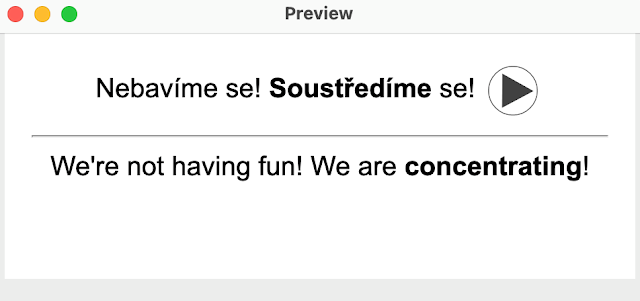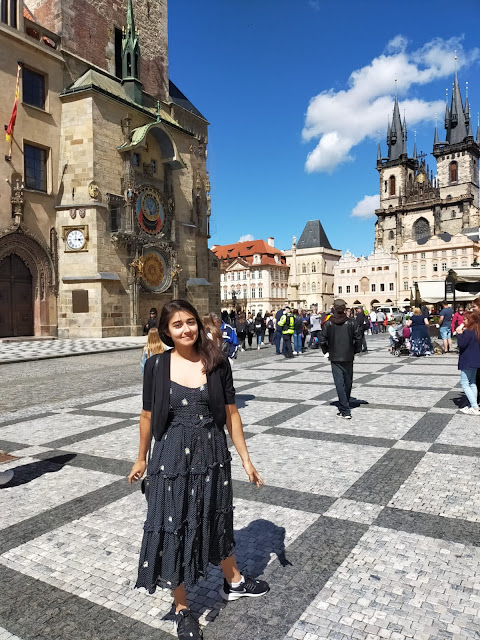Anshula Gandhi graduated with a joint major in mathematics and history at the Massachusetts Institute of Technology (MIT). She has continued to explore how the human brain does mathematics at the National Autonomous University of Mexico in Mexico City and at MIT’s Center for Brains, Minds, and Machines. Since April 2021, Anshula has combined mathematics, computer science, and logic to create algorithms for solving mathematical theorems at the Institute of Informatics, Robotics, and Cybernetics of the Czech Technical University in Prague. Before the transition to the Czech Republic, Anshula had started to learn the Czech language in an original and impressively effective way - through watching Czech TV shows. What are her tricks to become fluent in a foreign language without formal instruction? Why are TV shows better than movies? Read below to find out.
As soon as I found out I had received a Fulbright to spend time in Prague, I started learning Czech. At first, I felt like any effort to learn was doomed since I was living outside the country and didn’t have any Czech speakers to talk to on a daily basis. But I quickly realized I liked learning Czech a different way – making ten flashcards each day, made from sentences from my favorite Czech TV shows.
I started out with very simple sentences – just choosing the one word in the sentence I didn’t know to highlight and learn:Photo 2: From the show Vyprávěj. (A flashcard with two sentences in Czech: "Nebavíme se! Soustředíme se!" and English translation below: "We're not having fun! We are concentrating!").
And as my vocabulary expanded, more complicated sentences were within my grasp of understanding, and I could use a Czech dictionary to look up words:Photo 3: From the show Labyrint. (A flashcard with a phrase in Czech: "Tak já ti tady nebudu dávat kázání, jenom...",and English explanation of the keyword "kázání" below: "preaching.")
…until eventually, I could read simple Czech novels (with the help of listening to the audiobook at the same time, since hearing the intonation of the words made it quite a lot easier to comprehend) and made flashcards from sentences there:
Photo 4: From the book Bábovky. (A flashcard with a sentence in Czech: "Rychle ji spláchnout silnějším proudem vody z hlavy někam pryč." and English translation of the key word "spláchnout" below "wash away".)
Reviewing these flashcards each day allowed me to enjoy the highlights of my favorite Czech TV shows and books over and over. (And full disclosure – I didn’t come up with this way of making flashcards – rather, my “sentence mining” from shows and books was inspired by techniques from the language-learning site Refold).
Where to watch Czech TV in the US?
I was quite surprised by the amount of Czech TV I could watch in the US. Česká televize’s website allows much of its content to be shown in the US, and it has a huge selection of shows (the vast majority of which has Czech subtitles). When I first started learning Czech, when I couldn’t understand anything it all, I made a browser extension that translated their Czech subtitles to English, so I could still understand their shows despite not knowing any Czech.
And to decide what to watch, sometimes I took recommendations from my Czech language exchange partners. Other times, I would go on to ČSFD.cz, sort the shows by most viewers or best rating, and go down the list. (I really preferred watching Czech TV shows over movies, especially at the beginning, since with movies, I had to get used to new characters and a new plot line with every new movie. But with TV shows, I could spend hours and hours with the same characters and stories, and they tended to reuse the same vocabulary over and over, so it was less mentally draining for me).
And so, as I was learning Czech, I ended up watching a bunch of well-loved and popular Czech shows, as well as Czech shows that I personally love despite somewhat poor ratings in ČSFD (looking at you, Neviditelní).
Other Distance-Learning Mechanisms
Of course, I did other Czech-learning activities as well. I especially loved graded readers (I’d recommend Česká čítanka and the graded readers from Czech Step by Step. I also loved going through the textbook Česky, prosím, which had beautiful illustrations and came with an answer key at the back of the book, so it was perfect for self-teaching. And of course, I enjoyed my virtual language exchanges with kind Czech people who patiently listened to me try to repeat the same sentence over and over again five times until I had to resort to saying it in English.
I started out with very simple sentences – just choosing the one word in the sentence I didn’t know to highlight and learn:Photo 2: From the show Vyprávěj. (A flashcard with two sentences in Czech: "Nebavíme se! Soustředíme se!" and English translation below: "We're not having fun! We are concentrating!").
Where to watch Czech TV in the US?
I was quite surprised by the amount of Czech TV I could watch in the US. Česká televize’s website allows much of its content to be shown in the US, and it has a huge selection of shows (the vast majority of which has Czech subtitles). When I first started learning Czech, when I couldn’t understand anything it all, I made a browser extension that translated their Czech subtitles to English, so I could still understand their shows despite not knowing any Czech.
And to decide what to watch, sometimes I took recommendations from my Czech language exchange partners. Other times, I would go on to ČSFD.cz, sort the shows by most viewers or best rating, and go down the list. (I really preferred watching Czech TV shows over movies, especially at the beginning, since with movies, I had to get used to new characters and a new plot line with every new movie. But with TV shows, I could spend hours and hours with the same characters and stories, and they tended to reuse the same vocabulary over and over, so it was less mentally draining for me).
And so, as I was learning Czech, I ended up watching a bunch of well-loved and popular Czech shows, as well as Czech shows that I personally love despite somewhat poor ratings in ČSFD (looking at you, Neviditelní).
Other Distance-Learning Mechanisms
Of course, I did other Czech-learning activities as well. I especially loved graded readers (I’d recommend Česká čítanka and the graded readers from Czech Step by Step. I also loved going through the textbook Česky, prosím, which had beautiful illustrations and came with an answer key at the back of the book, so it was perfect for self-teaching. And of course, I enjoyed my virtual language exchanges with kind Czech people who patiently listened to me try to repeat the same sentence over and over again five times until I had to resort to saying it in English.
Photo 5: Anshula explores the city of Prague, Spring 2021. (Anshula poses for a picture in front of the Prague Astronomical Clock, tourists in the background.)
But…
Oddly enough, I learned the most Czech before actually coming here – most of my Czech learning stopped once I came to Prague. I think it was partly because once I came here, I spent a lot more time absorbed in my research (yay math!). And I also think it was partly because I wanted to form deeper friendships, which was a lot easier when speaking English (since almost anybody’s English is better than my Czech).
However now, after about a year of learning Czech, I’m happy I can understand most of what goes on at shops here in Prague, signs on the street, Czech websites, and casual conversations between friends or at the workplace, and I’m so grateful for that.
At this moment, one of my Czech friends has written a book in Czech, and we’re trying to use our joint-command of Czech and English to come up with the best translation of it into English as possible. It’s wonderfully fun, although I take forever deliberating over which vocabulary choice and word order is the best to use in the translation. It’s unlike anything I’ve ever done before.
I only have a few months to spend in the Czech Republic, and I’m so glad I started learning Czech when I did, because it turned out to be really helpful in my life here.
But…
Oddly enough, I learned the most Czech before actually coming here – most of my Czech learning stopped once I came to Prague. I think it was partly because once I came here, I spent a lot more time absorbed in my research (yay math!). And I also think it was partly because I wanted to form deeper friendships, which was a lot easier when speaking English (since almost anybody’s English is better than my Czech).
However now, after about a year of learning Czech, I’m happy I can understand most of what goes on at shops here in Prague, signs on the street, Czech websites, and casual conversations between friends or at the workplace, and I’m so grateful for that.
At this moment, one of my Czech friends has written a book in Czech, and we’re trying to use our joint-command of Czech and English to come up with the best translation of it into English as possible. It’s wonderfully fun, although I take forever deliberating over which vocabulary choice and word order is the best to use in the translation. It’s unlike anything I’ve ever done before.
I only have a few months to spend in the Czech Republic, and I’m so glad I started learning Czech when I did, because it turned out to be really helpful in my life here.




